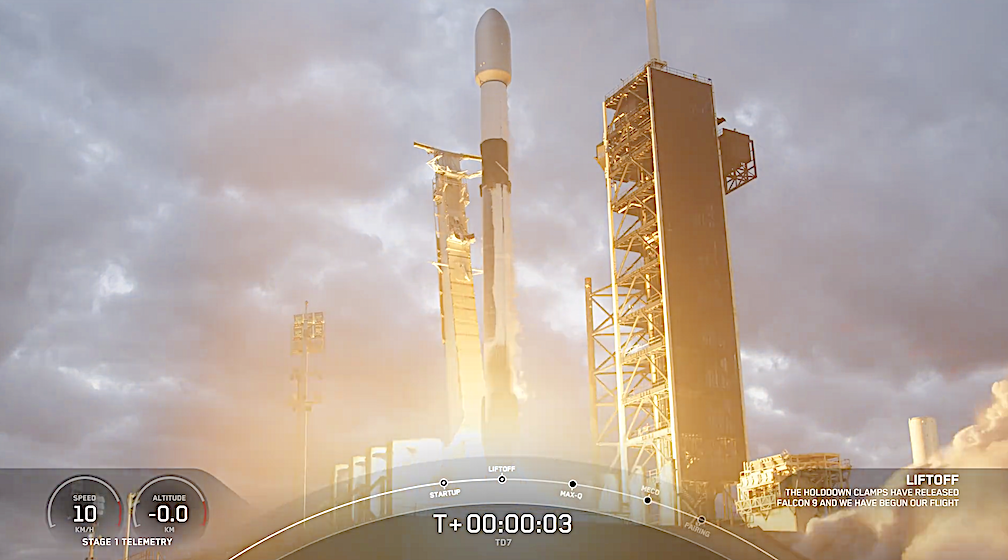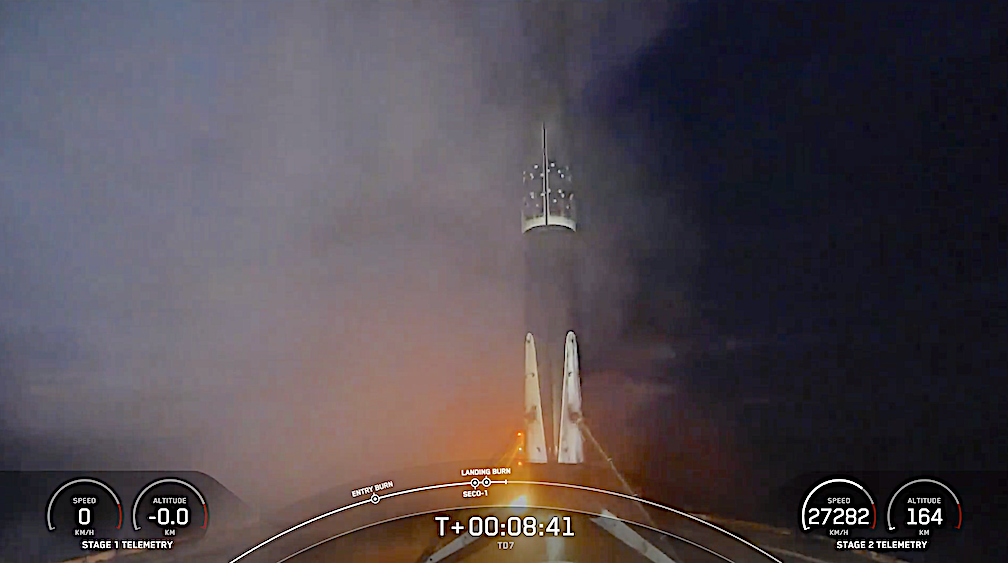
On Sunday, November 17 at 5:28 p.m. ET, SpaceX’s Falcon 9 launched the TD7 mission to orbit at 5:28 p.m. EST (2228 UTC) from Launch Complex 39A (LC-39A) at Kennedy Space Center in Florida. The mission and payload are a mystery and are referred to in two different names. The Federal Aviation Administration, calls the payload ‘Optus-X,’ while SpaceX calls the mission ‘TD7.’
Non of the specifics of the mission are known and the agencies are not using its original name. During the launch the SpaceX announcer referred to the payload as a “communications satellite”.
W. Ray Rutngamlug, Intelsat’s Associate General Counsel, reported Northrop Grumman’s role in the mission. “Intelsat clarifies that during the Optus X mission, Northrop Grumman will serve as the mission manager,” he wrote. “Northrop Grumman will build and send the commands to the Intelsat antenna, which will process and execute the commands. Telemetry received by Intelsat will be forwarded to Northrop Grumman.”

This was the 16th flight of the first stage booster supporting this mission that previously launched Crew-5, GPS III Space Vehicle 06, Inmarsat I6-F2, CRS-28, NG-20, and nine Starlink missions. This was SpaceX’s 369th successful landing.
Northrop Grumman-built Optus X for Australia’s Optus ready for SpaceX launch on Sunday

SpaceX will launch Northrop Grumman-built geostationary communications satellite, Optus X for Australian satellite operator Optus on Sunday, November 17 at 1:29 PM – 3:27 PM PST from Launch Complex 39A, Kennedy Space Center.
According to weather officials, there’s a 95% chance of favorable weather conditions at the time of the launch. The forecast calls for a temperature of 73°F, overcast clouds, 88% cloud cover and a wind speed of 7mph.
This is a project that has been planned over several years and a press release from Northrop Grumman in 2023 shared that under the launch agreement, SpaceX will provide launch services for a planned 2024 launch of the MRV and several MEPs. Optus, Australia’s largest satellite owner and operator, recently completed a purchase agreement with SpaceLogistics for installation of one of the MEPs on its D3 satellite in 2025.
“Our contracts with SpaceX and Optus are tangible evidence of our momentum and commitment to deliver second-generation on-orbit servicing technologies to the satellite industry.” said Vice President of Business Development for SpaceLogistics Joseph Anderson. “We are thrilled to have Optus as our premier MEP customer as we continue pioneering the future of space and expanding the realm of what is possible with on-orbit servicing and sustainment.”
The launch will mark the first time a robotic-capable spacecraft will ascend into space to provide persistent robotic servicing capabilities in geostationary orbit (GEO). The MRV will perform a series of on-orbit tests of its robotic-arm payload as it carries out its primary mission, installing MEPs on commercial satellites. The MEP, a small customer-owned, customer-controlled propulsion augmentation device, can provide six years of life extension for a typical 2,000 kg satellite in GEO.

“Optus’ partnership with SpaceLogistics will leverage their cutting edge MRV & MEP capability to increase the life of Optus’ D3 satellite. This innovative move along with the future launch of Optus 11 will benefit our customers.” said Ben White, managing director, wholesale, satellite and strategy at Optus.
The SpaceLogistics Mission Robotic Vehicle uses its sophisticated robotics to attach Mission Extension Pods, providing propulsion augmentation and extending the service lives of commercial satellites running out of fuel.
SpaceLogistics’ award-winning, first-generation Mission Extension Vehicles, MEV-1 and MEV-2, have provided propulsion and pointing control to commercial satellites in GEO since 2020. The sophisticated robotics of the next-generation MRV will expand the services SpaceLogistics currently offers to include augmentation, detailed robotic inspection, relocation and repair.
“Satellite owners are demonstrating enthusiasm and confidence for our life-extension solutions and the potential cost savings they could provide,” said Anderson. “Our Optus contract represents our third service contract with commercial satellite providers, and with several signed term sheets in queue our installation manifest for MEPs is already full for 2025 and nearly full for 2026.”
The MRV and MEP completed their respective preliminary design reviews in fall 2021 and remain on schedule for critical design reviews in 2022 and launch in 2024.
Optus provides satellite services to Australia and NZ Government departments, companies and broadcasters including Foxtel, ABC, SBS, Seven Network, and regional broadcasters such as Imparja Television, Sky New Zealand and Kordia, in addition to services in McMurdo Sound, Antarctica.
SpaceLogistics is the global leader in the development and deployment of on-orbit satellite servicing systems and the first and only company performing on-orbit servicing for commercial GEO satellites. Their planned series of vehicles will extend service life, provide enhanced capabilities and enable future missions for a variety of customers.
Northrop Grumman is a technology company with 90,000 employees focused on global security and human discovery. Their pioneering solutions equip their customers with capabilities they need to connect, advance and protect the U.S. and its allies.
